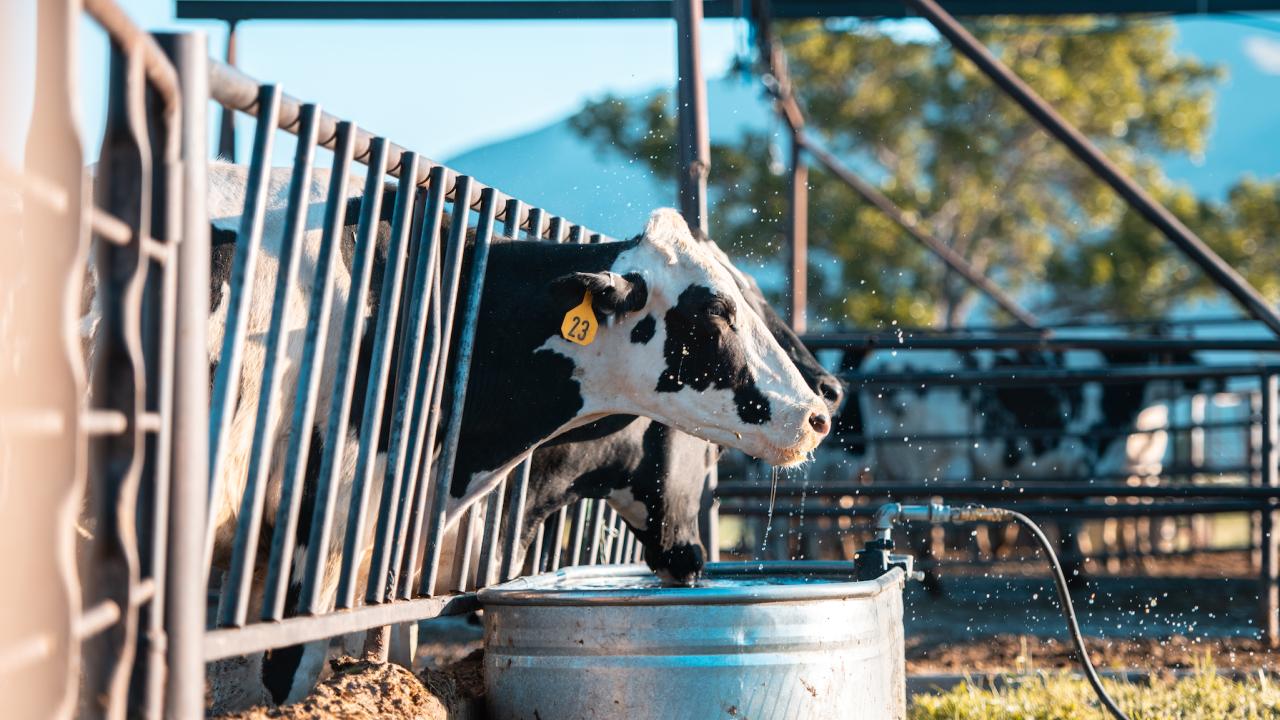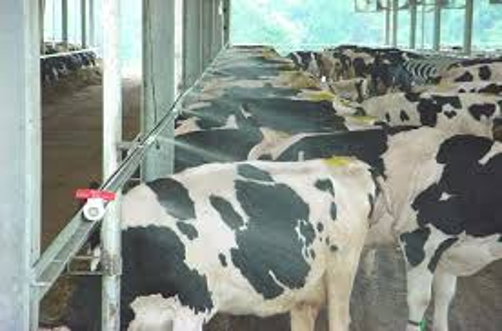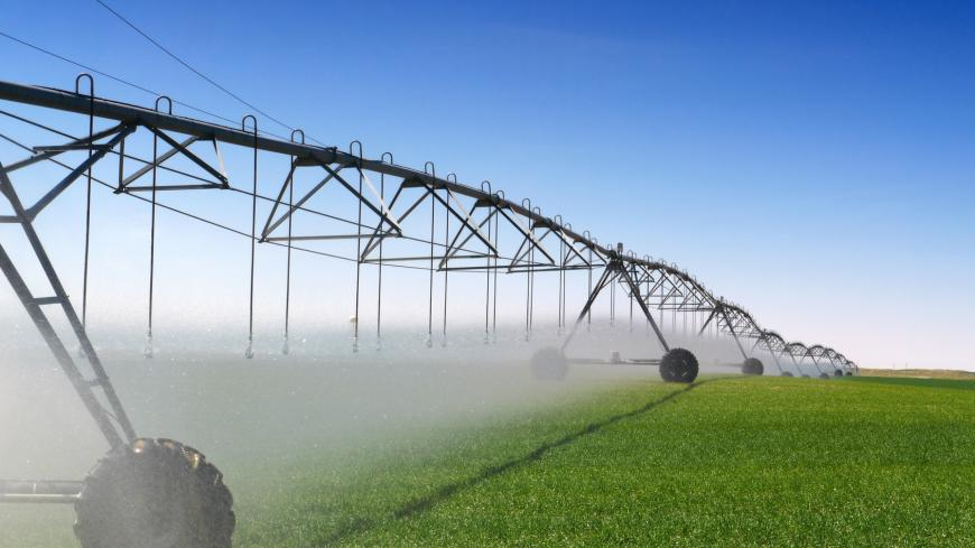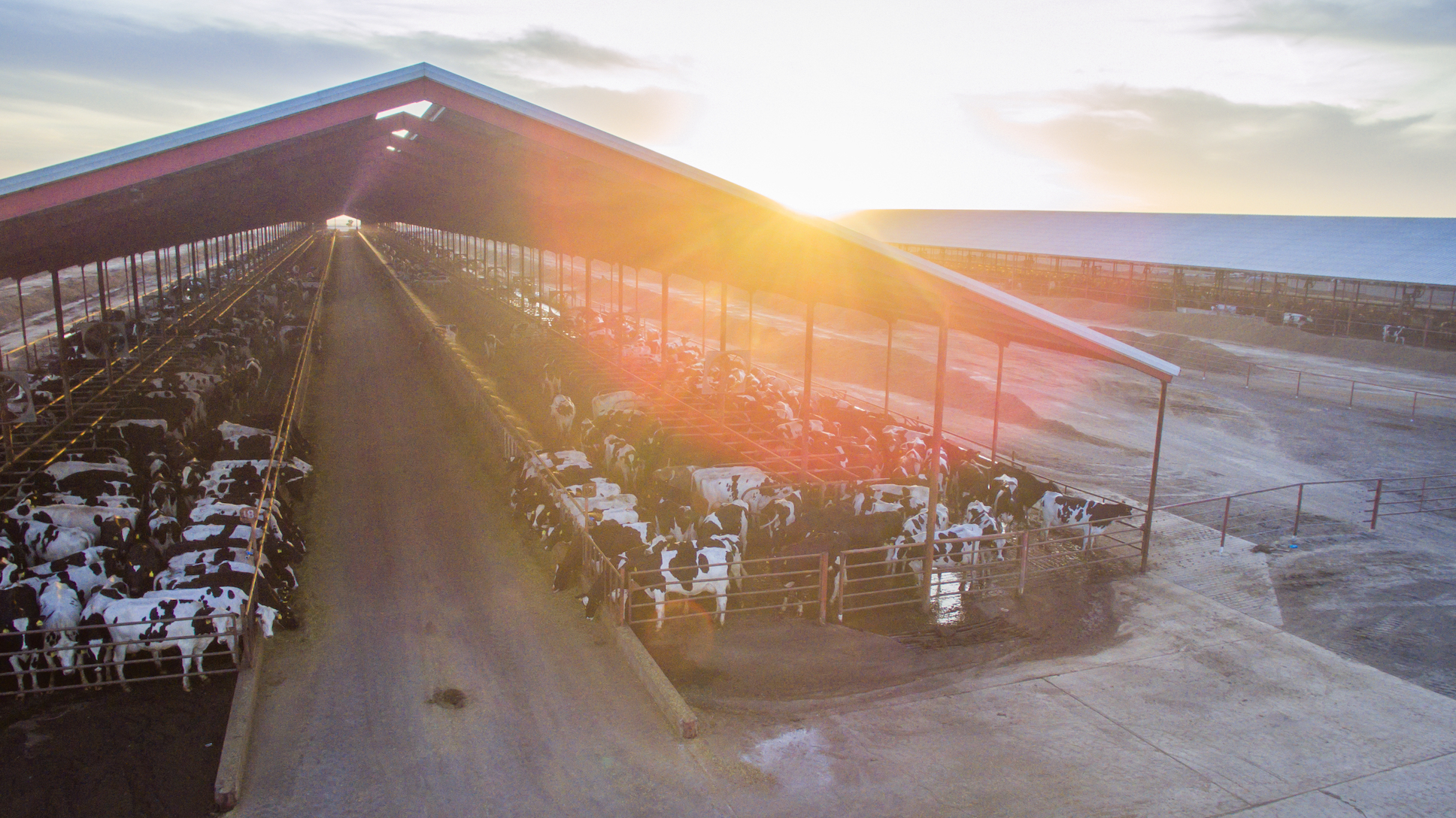
Reduced, Reused, Recycled—How Water is Managed on Western U.S. Dairies
By Conor McCabe, M.S., and Julia Fouts
California has experienced the driest winter months in 100 years, exacerbating an already drawn out drought that has led to water reductions in large swathes of the state for residents, especially for farmers. It’s a similar story throughout the Western United States where water conservation practices are a year-round necessity. Contrast that with the Eastern U.S. dairy states of Wisconsin, Michigan, and New York, where many of their crops do not have to be irrigated and too much water is a greater concern than not having enough.
Access to safe, quality water is more uncertain throughout the West today, meaning effective management of the precious resource is increasingly important. Nearly 50% of the country’s dairy production is in the Western U.S., but farms face an arid climate with moderate to extreme drought conditions. These harsh drought conditions correspond to an increased risk of fire, damages to agricultural land, and strained water sources. Marked gains in water use efficiency have been made in dairy production over the past 60 years, with the California dairy industry reducing its use of surface and groundwater intensity by almost 90%. By reducing, reusing, and recycling water, Western U.S. dairy farmers get the most out of every drop.
Not All Water is Created Equal
Before discussing water management on dairy farms, we should establish the various types of water that exist - blue, green, and gray. Blue water is sourced from streams, lakes, and groundwater. In contrast, green water is rainwater that falls every year and held in the soil for plant and crop utilization. Lastly gray water, although the name is the least appetizing of all, is recycled wastewater. All three of these types of water are utilized on Western U.S. dairies in differing quantities. Figure 1 demonstrates the water types needed to produce one metric ton of milk in the United States. Strikingly, over 80% of water usage is in the form of green water, or water from rainfall. In breaking into gray water alone, this water resource can be utilized four times before it makes it to its final destination. Despite the high use of green and gray water sources, research has focused on how farmers can limit use of blue water due to increasing competition among residential, wildlife, and agriculture stakeholders.

What parts of the farm require water?
Now that we know the different types of water, let’s delve deeper into water use and management practices on dairy farms. On a typical dairy farm in the West, the main users of water include cows, infrastructure, and crops, with water reused throughout the system.
In places like California where temperatures may reach 110°F (43.3 C) during the summer months, it is imperative to keep cows cool. Holstein cows, the black and white ones that are the predominant breed in the United States – and many countries around the world – begin to feel heat stress when temperatures rise above 68 F (20°C). Heat stress makes cows not want to eat, feel uncomfortable, and produce less milk. Chronic heat stress can also increase disease susceptibility and other welfare concerns if not properly managed. As global temperatures rise, solutions must be implemented to keep cows cool. One solution is to use a soaker system to cool cows with water when temperatures exceed the threshold (Figure 3). The water provides cooling relief directly to the skin via conductive cooling. However, the water doesn’t go to waste as it is subsequently collected and then stored to irrigate crops for future use. A common location for these soaker systems is directly next to the feed bunk to motivate cows to eat while getting the reward of cold water. On hot days, this water will subsequently evaporate off of the animal and more cool grey water will need to be applied. Cooling can be taken one step further with the use of high-speed fans in the pens to create evaporative cooling. Just as you may stand in front of a ‘swamp’ cooler during the peak of summer to cool down, the combination of soakers and fans apply the same concept. A soaker system for cows requires approximately 600 gallons of water a day for the average 100 foot long barn setup.

Milk is mostly water. Therefore, the more milk a cow produces, the more drinking water she will need to achieve that level of production. The average dairy cow drinks 30-50 gallons of water per day, which adds up across a group of cows. On average a cow produces nine gallons of milk per day, which means 20-33% of the water a cow drinks is going towards making highly nutritious dairy products. In addition to milk production, much of the water cows consume is also released when cows urinate. Scientists who have studied cow daily routines have found that cows urinate about 10-20 times a day to make about 8 gallons of urine. The urine is a beneficial fertilizer for farmers to use on their crops and will be collected and used in the irrigation system.
Many dairy cows in the Western United States are housed in open dry lot systems, which are large earth-floored pens with shade coverings. Some cows are also housed in freestall barns, which are undercover year-round and provide cows the freedom to go from the stall to the feed bunk whenever they choose – they’re like barns without walls. In both of these systems, cows will urinate and defecate; managing their waste is necessary for maintaining a clean environment. In freestall barns, one of the common methods is to use a flush lane system – similar to flushing a toilet – to remove the urine and feces from the pen. Flush lane systems help reduce some of the air pollutants associated with cattle production while removing waste from the pen. However, this isn’t “new” water but recycled water that is collected from previous flushes stored in on-farm lagoons. For every flush, the water starts at one end of the barn and picks up the manure and delivers it to a drain at the other end of the barn. This water and manure mixture is then collected and delivered to the manure lagoon to be used as crop fertilizer.
Before being used for cooling cows and field application, water is used to keep milk a healthy and safe food choice. For milk to achieve Grade “A” status, it must be cooled to 40 F (4 C) before leaving the dairy. This helps reduce bacteria growth along with extending the shelf life of dairy products. Therefore, milk must be cooled down from cow temperature to transportation temperature in a rapid and efficient manner.
To lower the temperature of milk, plate heat exchangers are utilized to have cold water run through pipes adjacent to the pipe carrying milk. This heat is then transferred from the milk to the water, lowering the temperature of milk and raising the temperature of the water. This countercurrent cooling process is the most efficient way to cool milk. Comparatively, thousands of gallons of milk could be cooled by refrigeration once it arrives at the holding tank – but this requires a greater amount of energy. Not to mention, this would need to be continuously running to offset new milk production filling up the milk holding tank before it leaves the farm.
It is important to note that water used to cool the milk never touches the milk as its only contact is through pipes that are located next to the freshly harvested milk. However, this isn’t the last time we’ll see this water as it will be collected and pooled for irrigation and other forms of cleaning. Along with cooling the milk, water is also needed for general cleaning and maintenance of the milking parlor. Parlors and milking equipment need to be thoroughly washed after every milking. Although these factors contribute to a farm’s total blue water use, they are a minor contribution compared to the other categories that require this water source (Figure 2).

Driving Down the Water Footprint of Dairy
Several innovations and practices are being implemented on farms that reduce the water footprint of a gallon of milk. Investigations are being made on increasing soil carbon, growing less water-demanding crops, and finding novel irrigation techniques.
The soil organic matter content represents the amount of carbon stored in a soil. There are a variety of practices that can be utilized to increase soil organic matter, including cover crops, reduced tillage, and compost. Think of the soil carbon as a sponge with the more soil carbon a farm has, the more water its soils are able to soak up and absorb. For every 1% increase in soil carbon, there is an observed 2% increase in soil water holding capacity. In many of the Southwest states that are facing drought and more variable rainfall patterns, there is almost a 5% increase in water holding capacity, which could reduce the reliance on outside water sources. In effect, this strategy can help farms increase their utilization of green water and lower the size of the blue water footprint. However, it may take years for farms to find the right combination of practices that work for their farms to increase soil organic matter given their environment, soil type, and available resources.
Of all the aspects of dairy farming, feed production is the largest source of blue water usage (Figure 2). The traditional dairy farm diet is made up of a corn silage and alfalfa base along with byproducts from the food processing industry. However, these crops are water intensive, with corn requiring 22-30 inches and alfalfa needing 20-46 inches of water annually to achieve high levels of production. In water-limited states such as California, there is ongoing research into opportunities to feed both safflower and sugar beet silage to dairy cows. These crops have a similar nutritional value compared to the traditional crops of corn and alfalfa, while requiring less water use to produce a successful harvest. Although research on cow performance is needed, these creative crops have the possibility to have the greatest impact on driving down dairy farm water use.
Reducing the amount of water required to grow crops is an important step in the right direction, but accurate delivery of water can provide a more immediate impact. Irrigation is utilized in areas with limited and/or variable rainfall in order to control the timing and amount of water available to plants. Many irrigation technologies have been used since the mid-20th century, and improvements have been made in water use efficiency throughout the years. Traditional crop irrigation occurs through flood irrigation, whereby water is delivered between rows of plants across the entire surface level. With flood irrigation, the entire field receives the same amount of water. This is great for the parts of the field where plants grow but not useful where the ground is bare between rows of crops. Therefore, flood irrigation can waste water, which is subsequently lost to evaporation. Fortunately, alternative irrigation systems are adopted throughout the dairy industry to avoid water loss.
One alternative to flooding an entire field is drip irrigation, which delivers water directly to the plant roots. Drip irrigation operates through the construction of hoses that are distributed between rows and have openings at the plant roots where the water can be utilized by the plants and not wasted via evaporation. Additionally, wastewater collected from parts of the dairy mentioned earlier can be added to subsurface drip irrigation, providing additional nutrients to plant roots. A pilot study in 2016 with wastewater added to subsurface drip irrigation found an increase in water-use nutrient use efficiency. However, adding this organic fertilizer to the irrigation system is easier said than done, as it requires additional infrastructure, planning, and management to get the nutrients to where they’re most needed.
Another irrigation technology is center pivot irrigation (Figure 4), which is composed of a pivot point (where water enters the system) and a long suspended pipe attached to wheels. The pivot point is a fixed point that will rotate the pipe around to spray water on crops, creating the crop circle pattern that you may see when flying in a plane over the western United States. Some of these central pivots are so large that the diameter of a crop circle can span up to a mile. A large advantage of center pivot irrigation systems is that they can be operated remotely, allowing farmers to precisely and efficiently control the amount of water applied to their fields. Through delivering water to where it is needed most, the dairy industry can make its greatest impact in reducing its water footprint.

Once the milk leaves the farm, it heads to a milk processor where it is turned into its final form (cheese, yogurt, or butter, etc.). These dairy products are mainly made up of fat and protein, but one main byproduct of production is the leftover “cow water” in which the fat and protein are filtered out from. This cow water can then be treated and used to irrigate crops or as in the case of California cheese producer Rumiano, this water is treated and then utilized to clean the plant or sent to Crescent City’s municipal supply. Farmers are predominantly paid on the amount of protein and fat present in their milk because that is what dairy products are made up of. Yet as of 2019, only 11% of the U.S.’s milk supply goes toward producing fluid milk that you would buy at the grocery store. Therefore, farmers do not need to sell whole raw milk to the processor. Over the past couple of decades, there has been a concept to concentrate milk fat and protein before the milk ever leaves the farm. Water can be removed from milk via reverse osmosis to increase fat and protein content by approximately three times normal milk. This extra water could then be used as an irrigation option for farms to increase gray water utilization. Not to mention this would also cut down on transportation costs because the amount of milk volume being shipped per cow would be decreased. Although this idea hasn’t been implemented on farms, as water becomes a more valuable resource, there may be greater interest in adopting this practice in drought stressed areas.
Western U.S. Dairy Can and Will Continue to Reduce and Recycle Water
For the foreseeable future, the Western states will continue to be a major contributor to the United States dairy industry. The need to conserve water will continue to rise with greater competition between agriculture, wildlife, and residential areas, as well as the impacts from climate change. Although dairy farmers have honed in on their water use and recycling over the past few decades, there is a continued need for improvement to get the most out of this precious and limited resource.

Too Much, Too Little, Just Right — Nitrogen Management on Dairy Farms
Mitloehner lab graduate student Conor McCabe. M.S., explains why dairy nitrogen management can have major economic, environmental, and human health implications
